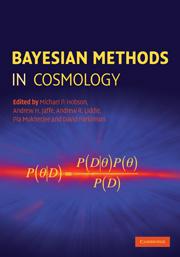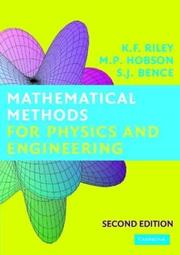| Listing 1 - 9 of 9 |
Sort by
|

ISBN: 9780511802461 9780521887946 9781107631755 9780511770159 0511770154 0521887941 1107211727 9781107211728 1282652982 9781282652989 9786612652981 6612652985 0511769318 9780511769313 0511767080 9780511767081 0511802463 0511768478 9780511768477 051176569X Year: 2010 Publisher: Cambridge, UK New York Cambridge University Press
Abstract | Keywords | Export | Availability | Bookmark
 Loading...
Loading...Choose an application
- Reference Manager
- EndNote
- RefWorks (Direct export to RefWorks)
"In recent years cosmologists have advanced from largely qualitative models of the Universe to precision modelling using Bayesian methods, in order to determine the properties of the Universe to high accuracy. This timely book is the only comprehensive introduction to the use of Bayesian methods in cosmological studies, and is an essential reference for graduate students and researchers in cosmology, astrophysics and applied statistics. The first part of the book focuses on methodology, setting the basic foundations and giving a detailed description of techniques. It covers topics including the estimation of parameters, Bayesian model comparison, and separation of signals. The second part explores a diverse range of applications, from the detection of astronomical sources (including through gravitational waves), to cosmic microwave background analysis and the quantification and classification of galaxy properties. Contributions from 24 highly regarded cosmologists and statisticians make this an authoritative guide to the subject"--Provided by publisher. "The first part of the book focuses on methodology, setting the basic foundations and giving a detailed description of techniques. It covers topics including the estimation of parameters, Bayesian model comparison, and separation of signals. The second part explores a diverse range of applications, from the detection of astronomical sources (including through gravitational waves), to cosmic microwave background analysis and the quantification and classification of galaxy properties. Contributions from 24 highly regarded cosmologists and statisticians make this an authoritative guide to the subject"--Provided by publisher.
Cosmology --- Bayesian statistical decision theory. --- Bayes' solution --- Bayesian analysis --- Statistical decision --- Astronomy --- Deism --- Metaphysics --- Statistical methods.
Book
ISBN: 1107484332 1283054930 0511914954 9786613054937 0511916760 0511917740 0511918720 0511913168 1139059092 Year: 2011 Publisher: Cambridge : Cambridge University Press,
Abstract | Keywords | Export | Availability | Bookmark
 Loading...
Loading...Choose an application
- Reference Manager
- EndNote
- RefWorks (Direct export to RefWorks)
This Student Solution Manual provides complete solutions to all the odd-numbered problems in Foundation Mathematics for the Physical Sciences. It takes students through each problem step-by-step, so they can clearly see how the solution is reached, and understand any mistakes in their own working. Students will learn by example how to arrive at the correct answer and improve their problem-solving skills.
Book
ISBN: 9786612908002 1282908006 1139059084 051191315X 0511914946 0511916752 0511917732 0511918712 0511911173 Year: 2011 Publisher: Cambridge : Cambridge University Press,
Abstract | Keywords | Export | Availability | Bookmark
 Loading...
Loading...Choose an application
- Reference Manager
- EndNote
- RefWorks (Direct export to RefWorks)
This Student Solution Manual provides complete solutions to all the odd-numbered problems in Essential Mathematical Methods for the Physical Sciences. It takes students through each problem step-by-step, so they can clearly see how the solution is reached, and understand any mistakes in their own working. Students will learn by example how to select an appropriate method, improving their problem-solving skills.
Book
ISBN: 9781139059084 9780521141024 Year: 2011 Publisher: Cambridge Cambridge University Press
Abstract | Keywords | Export | Availability | Bookmark
 Loading...
Loading...Choose an application
- Reference Manager
- EndNote
- RefWorks (Direct export to RefWorks)

ISBN: 0521813727 0521890675 Year: 2002 Publisher: Cambridge : Cambridge University Press,
Abstract | Keywords | Export | Availability | Bookmark
 Loading...
Loading...Choose an application
- Reference Manager
- EndNote
- RefWorks (Direct export to RefWorks)
Mathematical analysis. --- 517 --- 51-74 --- 517 Analysis --- Analysis --- 51-74 Mathematics--?-74 --- Mathematics--?-74 --- Mathematical analysis --- 517.1 Mathematical analysis --- 517.1. --- 517.1 --- Mathématiques --- Mathematics --- Analyse mathématique --- Engineering. --- Mathematics. --- Analyse mathématique --- Mathématiques --- Methodes mathematiques de la physique
Book
ISBN: 1139637096 128239455X 0511644132 9786612394553 0511790902 0511139438 0511140479 0511566557 0511139721 Year: 2006 Publisher: Cambridge : Cambridge University Press,
Abstract | Keywords | Export | Availability | Bookmark
 Loading...
Loading...Choose an application
- Reference Manager
- EndNote
- RefWorks (Direct export to RefWorks)
General Relativity: An Introduction for Physicists provides a clear mathematical introduction to Einstein's theory of general relativity. It presents a wide range of applications of the theory, concentrating on its physical consequences. After reviewing the basic concepts, the authors present a clear and intuitive discussion of the mathematical background, including the necessary tools of tensor calculus and differential geometry. These tools are then used to develop the topic of special relativity and to discuss electromagnetism in Minkowski spacetime. Gravitation as spacetime curvature is then introduced and the field equations of general relativity derived. After applying the theory to a wide range of physical situations, the book concludes with a brief discussion of classical field theory and the derivation of general relativity from a variational principle. Written for advanced undergraduate and graduate students, this approachable textbook contains over 300 exercises to illuminate and extend the discussion in the text.
Book
ISBN: 1107133386 128332959X 1139134094 9786613329592 113916497X 1139130390 0511202458 0511078161 0511076592 Year: 2002 Publisher: Cambridge : Cambridge University Press,
Abstract | Keywords | Export | Availability | Bookmark
 Loading...
Loading...Choose an application
- Reference Manager
- EndNote
- RefWorks (Direct export to RefWorks)
The new edition of this highly acclaimed textbook contains several major additions, including more than four hundred new exercises (with hints and answers). To match the mathematical preparation of current senior college and university entrants, the authors have included a preliminary chapter covering areas such as polynomial equations, trigonometric identities, coordinate geometry, partial fractions, binomial expansions, induction, and the proof of necessary and sufficient conditions. Elsewhere, matrix decompositions, nearly-singular matrices and non-square sets of linear equations are treated in detail. The presentation of probability has been reorganised and greatly extended, and includes all physically important distributions. New topics covered in a separate statistics chapter include estimator efficiency, distributions of samples, t- and F-tests for comparing means and variances, applications of the chi-squared distribution, and maximum likelihood and least-squares fitting. In other chapters the following topics have been added: linear recurrence relations, curvature, envelopes, curve-sketching, and more refined numerical methods.
Book
ISBN: 9781139059091 9780521141048 Year: 2011 Publisher: Cambridge Cambridge University Press
Abstract | Keywords | Export | Availability | Bookmark
 Loading...
Loading...Choose an application
- Reference Manager
- EndNote
- RefWorks (Direct export to RefWorks)
Book
ISBN: 9781139164979 9780521813723 9780521890670 Year: 2002 Publisher: Cambridge Cambridge University Press
Abstract | Keywords | Export | Availability | Bookmark
 Loading...
Loading...Choose an application
- Reference Manager
- EndNote
- RefWorks (Direct export to RefWorks)
| Listing 1 - 9 of 9 |
Sort by
|

 Search
Search Feedback
Feedback About UniCat
About UniCat  Help
Help News
News